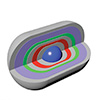| Apr 11, 2025 |
Researchers developed core@multi-shell upconversion nanoparticles that emit full-color light, enhancing color accuracy in advanced display technologies.
(Nanowerk News) Dr. Ho Seong Jang and colleagues at the Extreme Materials Research Center at the Korea Institute of Science and Technology (KIST) have developed an upconversion nanoparticle technology that introduces a core@multi-shell nanostructure, a multilayer structure in which multiple layers of shells surround a central core particle, and enables high color purity RGB light emission from a single nanoparticle by adjusting the infrared wavelength.
|
|
The findings have been published in Advanced Functional Materials (“Multicolor Fine-Tunable Upconversion Luminescence from a Single Nanoparticle for Full-Color Displays with a Wide Color Gamut”).
|
|
Luminescent materials are materials that light up on their own and are used in a variety of display devices, including TVs, tablets, monitors, and smartphones, to allow us to view a variety of images and videos. However, conventional two-dimensional flat displays cannot fully convey the three-dimensional dimensionality of the real world, limiting the sense of depth. The movie “Avatar” attracted a lot of attention for its 3D images, but audiences had to wear special glasses to experience the sense of depth, and glasses-free 3D displays were developed to solve this inconvenience, but they have the disadvantage of causing eye fatigue.
|
|
To solve these problems, three-dimensional volumetric display technology is being researched. This is a next-generation display technology that implements three-dimensional image information in a three-dimensional space, which requires upconversion nanoparticles that absorb infrared light and emit visible light.
|
|
In particular, upconversion nanoparticles that can emit all three primary colors of light-red (R), green (G), and blue (B)-from a single nanoparticle are required, but existing materials either emit only one color from a single nanoparticle or, even if R/G/B emission is possible, brightness is low or the range of color reproduction is limited due to a narrow color gamut.
|
 |
| a) Schematic illustration showing blue, green, and red UC luminescence from i) blue-emitting component (single domain), ii) green-emitting component (C@S-structured domain), and iii) red-emitting component (single domain) under 980 nm, 800 nm, and 1532 nm NIR light, respectively. b) Six distinct RGB UC luminescent C@MS UCNPs consisting of blue-emitting single domain, green-emitting C@S-structured domain, and red-emitting single domain shown in (a) [i) B-G-R-structured C@6S, ii) B-R-G-structured C@6S, iii) G-B-R-structured C@6S, iv) G-R-B-structured C@6S, v) R-G-B-structured C@6S, and vi) R-B-G-structured C@6S UCNPs]. (© Wiley-VCH Verlag)
|
|
The KIST researchers controlled the material composition of the core and shell to induce R/G/B luminescence from a single nanoparticle, and applied three wavelengths of near-infrared light to produce R/G/B luminescence at different excitation wavelengths.
|
|
In particular, they designed the core to emit green light, the inner shell to emit red light, and the outer shell to emit blue light, achieving high color purity and strong luminescence intensity of R/G/B luminescence in a single nanoparticle. The nanoparticles developed by the researchers can realize various colors by applying multiple wavelengths of near-infrared light simultaneously, achieving a wide color gamut of 94.2% of the NTSC color space and 133% of the sRGB color space.
|
|
The researchers also demonstrated the possibility of realizing 3D volumetric displays using upconversion nanoparticles by fabricating transparent upconversion nanoparticle- polymer composites to display various color images.
|
|
“Upconversion nanoparticles that can absorb near-infrared light and produce high color reproduction full-color luminescence will enable the commercialization of 3D volumetric displays that can allow us to view true 3D images. These upconversion nanoparticles can be used not only in the display field but also as a security material to prevent counterfeiting and tampering,” said Dr. Ho Seong Jang.
|


